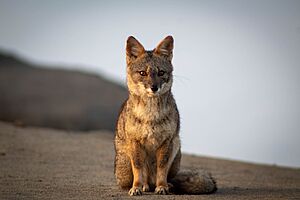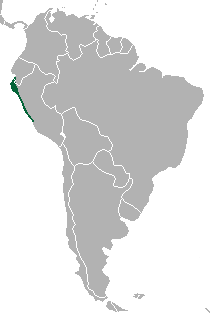Sechuran fox facts for kids
Quick facts for kids Sechuran fox |
|
|---|---|
 |
|
| Conservation status | |
| Scientific classification | |
| Genus: |
Lycalopex
|
| Species: |
sechurae
|
 |
|
| Sechuran fox range | |
| Synonyms | |
|
Pseudalopex sechurae |
|
The Sechuran fox (Lycalopex sechurae) is a small fox from South America. It is also called the Peruvian desert fox or the Sechuran zorro. This fox gets its name from the Sechura Desert in northwestern Peru, where it lives.
It is one of ten types of wild dogs, called canids, that live only in South America. This fox lives in a narrow area along the coast of Peru and southern Ecuador. You can find it in dry places like deserts, cliffs, and beaches, especially west of the Andes Mountains. Its scientific name, Lycalopex, comes from Greek words meaning "wolf" and "fox."
Scientists believe the Sechuran fox evolved from older canids a long time ago. It has special traits that help it survive in its dry home. While we don't know everything about its history, new studies are helping us learn more.
There are about 5,000 Sechuran foxes left, based on a 2022 study. The biggest dangers to these foxes are people. Their homes are being destroyed by cutting down forests. Also, some foxes are hunted, but this is a smaller problem.
Contents
What the Sechuran Fox Looks Like
The Sechuran fox is a small canid. It usually weighs between 2.6 and 4.2 kilograms (about 6 to 9 pounds). Its body is about 50 to 78 centimeters (20 to 31 inches) long, and its tail is 27 to 34 centimeters (11 to 13 inches) long.
Its fur is mostly gray with a mix of colors, which is called agouti. Its belly is white or cream. It has reddish-brown marks behind its ears, around its eyes, and on its legs. The fox's nose is dark gray, and a gray band crosses its chest. The tip of its tail is black. It has small teeth, which are good for eating insects and dry plants.
Where Sechuran Foxes Live
The Sechuran fox was first found in the Sechura Desert. It lives in dry areas in southwestern Ecuador and western Peru. These foxes can be found from sea level up to at least 1,000 meters (about 3,300 feet) high in the mountains. They live in deserts, dry forests, and along beaches, especially near the western foothills of the Andes. There are no different types or subspecies of the Sechuran fox.
How Sechuran Foxes Evolved
Scientists are still studying the full history of the Sechuran fox. It is thought that the Falkland Islands wolf, which died out in 1876, might be a close relative of the Lycalopex group of foxes.
Fossils of Sechuran foxes have been found from the late Pleistocene era in Ecuador and Peru. This is close to where they live today. Genetic tests show that Darwin's fox, which lives in Chile, is the closest living relative to the Sechuran fox.
Fox Family Tree
The first fox ancestors came to South America during the Miocene era. This happened when a land bridge formed between North and South America, called the Great American Biotic Interchange. Many different types of wild dogs, including the Sechuran fox, quickly evolved from these ancestors.
Most South American canids, including the Lycalopex foxes, share one common ancestor. This ancestor lived about 3.5 to 4 million years ago. The Sechuran fox was the second of the six Lycalopex species to evolve. This happened about 1.3 million years after the first canid arrived.
Scientists believe that the main group of ancestors split into two. One group moved east of the Andes Mountains, and the other moved west. The ancestors of the Lycalopex foxes likely moved to the west-Andean region about 1 million years ago. This was when dry, savanna-like areas, which the Sechuran fox likes today, became common.
Fox Genetics
Studies suggest that the Sechuran fox is closely related to the Falkland Islands wolf. The Sechuran fox also has very little gene flow, meaning it doesn't mix its genes much with other Lycalopex species. Because it was one of the first species in its group to evolve, it is quite genetically separate from the others.
The Sechuran fox also has low genetic variety. This is often seen in animals with small populations, like Darwin's fox. Darwin's fox also lives in a small area west of the Andes, including an island.
Special Ways They Survive
The Sechuran fox is the smallest of all the Lycalopex species. It also doesn't have red fur, which sets it apart from some other foxes in its group. Its teeth have changed over time. Older fossils show longer molars than what we see in foxes today.
This fox is very adaptable, which has helped it survive. It can eat many different things. If there isn't much meat or insects, it can survive by eating only plants. Scientists think that eating more plants might have made their molars smaller.
It is also believed that the Sechuran fox can live for long periods without drinking water. This is a special ability for a mammal, especially since water is scarce in its habitat. More studies are needed to confirm how long they can go without water.
Behavior and Diet
The Sechuran fox is nocturnal, meaning it is active at night. During the day, it rests in a den it digs in the ground. These foxes usually live alone, but sometimes they are seen traveling in pairs. Pups are born in October and November, but not much else is known about how they reproduce.
This fox is an opportunistic feeder, meaning it eats whatever it can find. Its diet changes depending on the season and where it lives. It eats seed pods, especially from the Prosopis juliflora shrub and caper bushes. It also eats fruit from Cordia and mito plants. If needed, it can survive on a diet of only plants.
More often, the Sechuran fox also eats insects, small rodents, bird eggs, and dead animals. It can likely get all the water it needs from its food, so it doesn't have to drink often. Sechuran foxes help spread plant seeds, just like some bats and deer do.
Conservation Status
Sechuran foxes are common in Ecuador. They are known to sometimes hunt local farm animals, like chickens. Because of this, people hunt them to protect their livestock. Their body parts are also used in local crafts, traditional medicine, or special rituals.
In Ecuador, the animal is considered to be at Low Risk. In Peru, hunting them is not allowed without a special permit. The International Union for Conservation of Nature (IUCN) lists the Sechuran fox as Near Threatened. This means it could become endangered in the future if its population continues to decline.


